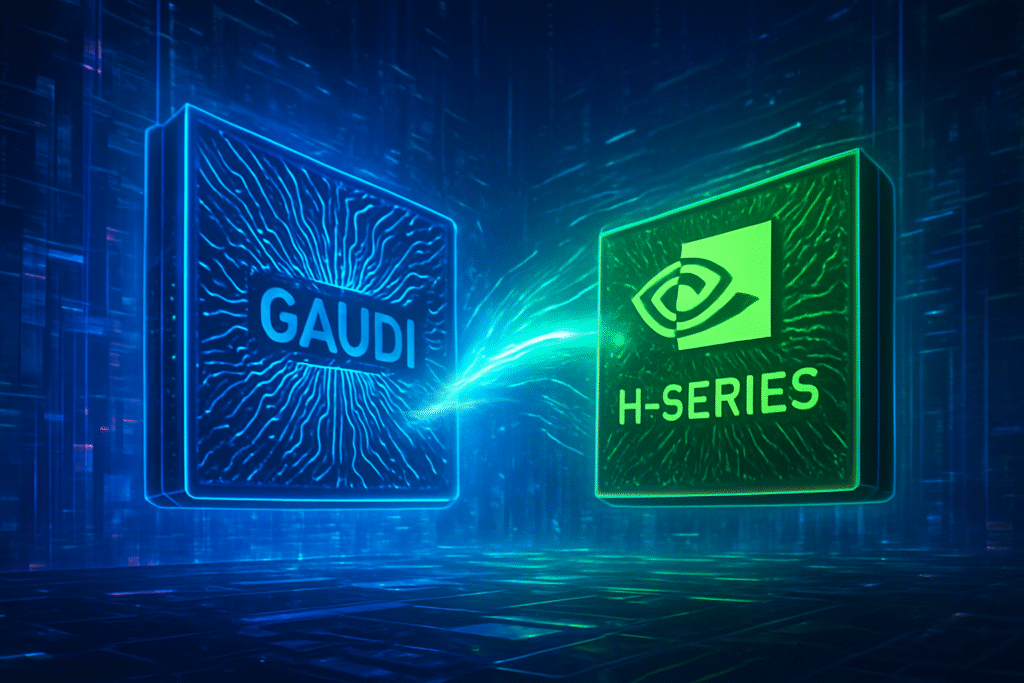
In an electrifying race for artificial intelligence supremacy, the tech world is witnessing an intense battle between semiconductor titans Intel and NVIDIA. As of November 2025, the rivalry between Intel's (NASDAQ: INTC) Gaudi accelerators and NVIDIA's (NASDAQ: NVDA) H-series GPUs has reached a fever pitch, with each company vying for dominance in the rapidly expanding and critical AI chip market. This fierce competition is not merely a commercial skirmish but a pivotal force driving innovation, shaping market strategies, and dictating the future trajectory of AI development across industries.
While NVIDIA, with its formidable H100 and H200 GPUs and the highly anticipated Blackwell (B-series) architecture, continues to hold a commanding lead, Intel is strategically positioning its Gaudi 3 as a compelling, cost-effective alternative. Intel's aggressive push aims to democratize access to high-performance AI compute, challenging NVIDIA's entrenched ecosystem and offering enterprises a more diversified and accessible path to AI deployment. The immediate significance lies in the increased competition, offering customers more choice, driving a focus on inference and cost-efficiency, and potentially shifting software dynamics towards more open ecosystems.
Architectural Innovations and Performance Benchmarks: A Technical Deep Dive
The architectural differences between Intel's Gaudi 3 and NVIDIA's H-series GPUs are fundamental, reflecting distinct philosophies in AI accelerator design.
Intel Gaudi 3: Built on an advanced 5nm process, Gaudi 3 is a purpose-built AI-Dedicated Compute Engine, featuring 64 AI-custom and programmable Tensor Processor Cores (TPCs) and eight Matrix Multiplication Engines (MMEs), each capable of 64,000 parallel operations. A key differentiator is its integrated networking, boasting twenty-four 200Gb Ethernet ports for flexible, open-standard scaling. Gaudi 3 offers 1.8 PetaFLOPS for BF16 and FP8 precision, 128GB of HBM2e memory with 3.7 TB/s bandwidth, and 96MB of on-board SRAM. It represents a significant leap from Gaudi 2, delivering 4 times the AI compute power for BF16, 1.5 times the memory bandwidth, and double the networking bandwidth. Intel claims Gaudi 3 is up to 40% faster than the NVIDIA H100 in general AI acceleration and up to 1.7 times faster for training Llama 2-13B models. For inference, it anticipates 1.3 to 1.5 times the performance of the H200/H100, with up to 2.3 times better power efficiency.
NVIDIA H-series (H100, H200, B200): NVIDIA's H-series GPUs leverage the Hopper architecture (H100, H200) and the groundbreaking Blackwell architecture (B200).
The H100, based on the Hopper architecture and TSMC's 4N process, features 80 billion transistors. Its core innovation for LLMs is the Transformer Engine, dynamically adjusting between FP8 and FP16 precision. It provides up to 3,341 TFLOPS (FP8 Tensor Core) and 80GB HBM3 memory with 3.35 TB/s bandwidth, utilizing NVIDIA's proprietary NVLink for 900 GB/s interconnect. The H100 delivered 3.2x more FLOPS for BF16 and introduced FP8, offering 2-3x faster LLM training and up to 30x faster inference compared to its predecessor, the A100.
The H200 builds upon Hopper, primarily enhancing memory with 141GB of HBM3e memory and 4.8 TB/s bandwidth, nearly doubling the H100's memory capacity and increasing bandwidth by 1.4x. This is crucial for larger generative AI datasets and LLMs with longer context windows. NVIDIA claims it offers 1.9x faster inference for Llama 2 70B and 1.6x faster inference for GPT-3 175B compared to the H100.
The B200 (Blackwell architecture), built on TSMC's custom 4NP process with 208 billion transistors, is designed for massive generative AI and agentic AI workloads, targeting trillion-parameter models. It introduces fifth-generation Tensor Cores with ultra-low-precision FP4 and FP6 operations, a second-generation Transformer Engine, and an integrated decompression engine. The B200 utilizes fifth-generation NVLink, providing an astonishing 10 TB/s of system interconnect bandwidth. Blackwell claims up to a 2.5x increase in training performance and up to 25x better energy efficiency for certain inference workloads compared to Hopper. For Llama 2 70B inference, the B200 can process 11,264 tokens per second, 3.7 times faster than the H100.
The key difference lies in Intel's purpose-built AI accelerator architecture with open-standard Ethernet networking versus NVIDIA's evolution from a general-purpose GPU architecture, leveraging proprietary NVLink and its dominant CUDA software ecosystem. While NVIDIA pushes the boundaries of raw performance with ever-increasing transistor counts and novel precision formats like FP4, Intel focuses on a compelling price-performance ratio and an open, flexible ecosystem.
Impact on AI Companies, Tech Giants, and Startups
The intensifying competition between Intel Gaudi 3 and NVIDIA H-series chips is profoundly impacting the entire AI ecosystem, from nascent startups to established tech giants.
Market Positioning: As of November 2025, NVIDIA maintains an estimated 94% market share in the AI GPU market, with its H100 and H200 in high demand, and the Blackwell architecture set to further solidify its performance leadership. Intel, with Gaudi 3, is strategically positioned as a cost-effective, open-ecosystem alternative, primarily targeting enterprise AI inference and specific training workloads. Intel projects capturing 8-9% of the global AI training market in select enterprise segments.
Who Benefits:
- AI Companies (End-users): Benefit from increased choice, potentially leading to more specialized, cost-effective, and energy-efficient hardware. Companies focused on AI inference, fine-tuning, and Retrieval-Augmented Generation (RAG) workloads, especially within enterprise settings, find Gaudi 3 attractive due to its claimed price-performance advantages and lower total cost of ownership (TCO). Intel claims Gaudi 3 offers 70% better price-performance inference throughput of Llama 3 80B over NVIDIA H100 and up to 50% faster training times for models like GPT-3 (175B).
- Tech Giants (Hyperscalers): While still significant purchasers of NVIDIA chips, major tech giants like Google (NASDAQ: GOOGL), Amazon (NASDAQ: AMZN), and Microsoft (NASDAQ: MSFT) are increasingly developing their own custom AI chips (e.g., Google's Ironwood TPU, Amazon's Trainium 3, Microsoft's Maia) to optimize for specific workloads, reduce vendor reliance, and improve cost-efficiency. This competition offers them more leverage and diversification.
- Startups: Benefit from market diversification. Intel's focus on affordability and an open ecosystem could lower the barrier to entry, providing access to powerful hardware without the premium cost or strict ecosystem adherence often associated with NVIDIA. This fosters innovation by enabling more startups to develop and deploy AI models.
Competitive Implications: The market is bifurcated. NVIDIA remains the leader for cutting-edge AI research and large-scale model training requiring maximum raw performance and its mature CUDA software stack. Intel is carving a niche in enterprise AI, where cost-efficiency, power consumption, and an open ecosystem are critical. The demand for NVIDIA's H200 and Blackwell platforms continues to outstrip supply, creating opportunities for alternatives.
Potential Disruption: Intel's Gaudi 3, coupled with an open ecosystem, represents a significant challenge to NVIDIA's near-monopoly, especially in the growing enterprise AI market and for inference workloads. The rise of custom silicon by tech giants poses a long-term disruption to both Intel and NVIDIA. Geopolitical factors, such as U.S. export controls on high-performance AI chips to China, are also influencing market dynamics, pushing countries like China to boost domestic chip production and reduce reliance on foreign vendors.
Wider Significance in the Broader AI Landscape
This intense AI chip rivalry is a defining moment in the broader AI landscape, signaling a new era of innovation, strategic realignments, and global competition.
Accelerated Innovation and Market Diversification: Intel's aggressive challenge forces both companies to innovate at an unprecedented pace, pushing boundaries in chip design, manufacturing (e.g., Intel's 18A process, NVIDIA's advanced packaging), and software ecosystems. This competition fosters market diversification, offering developers and enterprises more hardware options beyond a single vendor, thereby reducing dependency and potentially lowering the significant costs of deploying AI models.
Strategic Industry Realignment: The competition has even led to unexpected strategic alignments, such as NVIDIA's investment in Intel, signaling a pragmatic response to supply chain diversification and an interest in Intel's advanced X86 architecture. Intel is also leveraging its foundry services to become a key manufacturer for other companies developing custom AI chips, further reshaping the global chip production landscape.
Influence on Software Ecosystems: NVIDIA's strength is heavily reliant on its proprietary CUDA software stack. Intel's efforts with its oneAPI framework represent a significant attempt to offer an open, cross-architecture alternative. The success of Intel's hardware will depend heavily on the maturity and adoption of its software tools, potentially driving a shift towards more open AI development environments.
Impacts and Concerns: The rivalry is driving down costs and increasing accessibility of AI infrastructure. It also encourages supply chain resilience by diversifying hardware suppliers. However, concerns persist regarding the supply-demand imbalance, with demand for AI chips predicted to outpace supply into 2025. The immense energy consumption of AI models, potentially reaching gigawatts for frontier AI by 2030, raises significant environmental and operational concerns. Geopolitical tensions, particularly between the US and China, heavily influence the market, with export restrictions reshaping global supply chains and accelerating the drive for self-sufficiency in AI chips.
Comparisons to Previous AI Milestones: The current AI chip rivalry is part of an "AI super cycle," characterized by an unprecedented acceleration in AI development, with generative AI performance doubling every six months. This era differs from previous technology cycles by focusing specifically on AI acceleration, marking a significant pivot for companies like NVIDIA. This competition builds upon foundational AI milestones like the Dartmouth Workshop and DeepMind's AlphaGo, but the current demand for specialized AI hardware, fueled by the widespread adoption of generative AI, is unprecedented. Unlike previous "AI winters," the current demand for AI chips is sustained by massive investments and national support, aiming to avoid downturns.
Future Developments and Expert Predictions
The AI chip landscape is poised for continuous, rapid evolution, with both near-term and long-term developments shaping its trajectory.
NVIDIA's Roadmap: NVIDIA's Blackwell architecture (B100, B200, and GB200 Superchip) is expected to dominate high-end AI server solutions through 2025, with production reportedly sold out well in advance. NVIDIA's strategy involves a "one-year rhythm" for new chip releases, with the Rubin platform slated for initial shipments in 2026. This continuous innovation, coupled with its integrated hardware and CUDA software ecosystem, aims to maintain NVIDIA's performance lead.
Intel's Roadmap: Intel is aggressively pursuing its Gaudi roadmap, with Gaudi 3 positioning itself as a strong, cost-effective alternative. Intel's future includes the "Crescent Island" data center GPU following Gaudi, and client processors like Panther Lake (18A node) for late 2025 and Nova Lake (potentially 14A/2nm) in 2026. Intel is also integrating AI acceleration into its Xeon processors to facilitate broader AI adoption.
Broader Market Trends: The global AI chip market is projected to reach nearly $92 billion in 2025, driven by generative AI. A major trend is the increasing investment by hyperscale cloud providers in developing custom AI accelerator ASICs (e.g., Google's TPUs, AWS's Trainium and Inferentia, Microsoft's Maia, Meta's Artemis) to optimize performance and reduce reliance on third-party vendors. Architectural innovations like heterogeneous computing, 3D chip stacking, and silicon photonics will enhance density and energy efficiency. Long-term predictions include breakthroughs in neuromorphic chips and specialized hardware for quantum computing.
Potential Applications: The demand for advanced AI chips is fueled by generative AI and LLMs, data centers, cloud computing, and a burgeoning edge AI market (autonomous systems, IoT devices, AI PCs). AI chips are also crucial for scientific computing, healthcare, industrial automation, and telecommunications.
Challenges: Technical hurdles include high power consumption and heat dissipation, as well as memory bandwidth bottlenecks. Software ecosystem maturity for alternatives to CUDA remains a challenge. The escalating costs of designing and manufacturing advanced chips (up to $20 billion for modern fabrication plants) are significant barriers. Supply chain vulnerabilities and geopolitical risks, including export controls, continue to impact the market. A global talent shortage in the semiconductor industry is also a pressing concern.
Expert Predictions: Experts foresee a sustained "AI Supercycle" characterized by continuous innovation and market expansion. They predict a continued shift towards specialized AI chips and custom silicon, with the market for generative AI inference growing faster than training. Architectural advancements, AI-driven design and manufacturing, and a strong focus on energy efficiency will define the future. Geopolitical factors will continue to influence market dynamics, with Chinese chipmakers facing challenges in matching NVIDIA's prowess due to export restrictions.
Comprehensive Wrap-up and Future Outlook
The intense competition between Intel's Gaudi accelerators and NVIDIA's H-series GPUs is a defining characteristic of the AI landscape in November 2025. This rivalry, far from being a zero-sum game, is a powerful catalyst driving unprecedented innovation, market diversification, and strategic realignments across the entire technology sector.
Key Takeaways: NVIDIA maintains its dominant position, driven by continuous innovation in its H-series and Blackwell architectures and its robust CUDA ecosystem. Intel, with Gaudi 3, is strategically targeting the market with a compelling price-performance proposition and an open-source software stack, aiming to reduce vendor lock-in and make AI more accessible. Their divergent strategies, one focusing on integrated, high-performance proprietary solutions and the other on open, cost-effective alternatives, are both contributing to the rapid advancement of AI hardware.
Significance in AI History: This competition marks a pivotal phase, accelerating innovation in chip architecture and software ecosystems. It is contributing to the democratization of AI by potentially lowering infrastructure costs and fostering a more resilient and diversified AI supply chain, which has become a critical geopolitical and economic concern. The push for open-source AI software ecosystems, championed by Intel, challenges NVIDIA's CUDA dominance and promotes a more interoperable AI development environment.
Long-Term Impact: The long-term impact will be transformative, leading to increased accessibility and customization of AI, reshaping the global semiconductor industry through national strategies and supply chain dynamics, and fostering continuous software innovation beyond proprietary ecosystems. This intense focus could also accelerate research into new computing paradigms, including quantum chips.
What to Watch For: In the coming weeks and months, monitor the ramp-up of NVIDIA's Blackwell series and its real-world performance benchmarks, particularly against Intel's Gaudi 3 for inference and cost-sensitive training workloads. Observe the adoption rates of Intel Gaudi 3 by enterprises and cloud providers, as well as the broader impact of Intel's comprehensive AI roadmap, including its client and edge AI chips. The adoption of custom AI chips by hyperscalers and the growth of open-source software ecosystems will also be crucial indicators of market shifts. Finally, geopolitical and supply chain developments, including the ongoing impact of export controls and strategic alliances like NVIDIA's investment in Intel, will continue to shape the competitive landscape.
This content is intended for informational purposes only and represents analysis of current AI developments.
TokenRing AI delivers enterprise-grade solutions for multi-agent AI workflow orchestration, AI-powered development tools, and seamless remote collaboration platforms.
For more information, visit https://www.tokenring.ai/.






